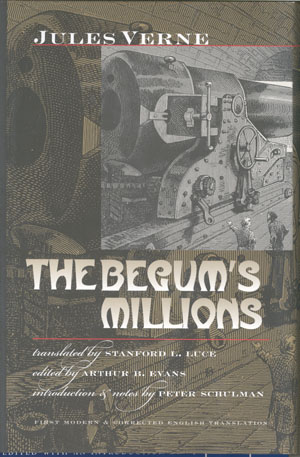|
Jules Verne. The Begum's Millions. Trans. Stanford L. Luce. Ed. Arthur B. Evans. Introduction and notes by Peter Schulman. Middletown, CT: Wesleyan UP, 2005
5 1/2 x 8 1/2" 308 pp. 45 B&W illus.
$29.95 Cloth, 0-8195-6796-5

“This edition of The Begum's Millions is a significant work of scholarship and an important contribution to the ongoing project of reclaiming and redefining Verne's reputation in the English-speaking world.”— Gary K. Wolfe, Professor of Humanities and English, Roosevelt University
“This book captures Verne's verve and vision, never lapsing in its narrative drive, throwing off ideas in joyful glee. The 19th Century lives on!”—Gregory Benford, Professor of Physics, University of California, Irvine
“Verne's vision of the near-future is uncannily accurate, not so much in his depictions of technologies of the coming era (for which he is perhaps too often praised) as for —the greater achievement —his portrayals of their effects on society and the human spirit.”—Terry Harpold, Asst. Professor of English, University of Florida
“First we need to do a little context wonking. It only hurts for a little while. Les Cinq cents millions de la Bégum , a fairly short novel by Jules Verne's standards, was first published in 1879 as part of the 19th volume of his great series of Voyages Extraordinaires, of which he completed 56 volumes before his death in 1905. His son, Michel Verne, was substantially responsible for a further nine titles. These 50 or so novels fit together into an enormous kaleidoscope of Views of the World from Europe, a multifaceted glass upon the century that created the 20th century that created us; many of the later volumes of the series seem now, a century after his death, to give off a prophetic thanatopic glow. Peter Schulman's introduction to this volume of The Wesleyan Early Classics of Science Fiction Series (overall editor Arthur B. Evans) has much to say on the assocation of guns and death, militarism and thanatopsis, in Jules Verne. Within the hearty tramp of the surface story of The Begum's Millions , dead bones do surely march. There is something prophetically exsanguinated about this first example of his late fiction, as though something up there from the next century had gorged on it, Doctor Death mounting Europa. [...] In 1879 or so, anglophone readers would not have been likely to have understood The Begum's Millions as marking a new phase in Verne's career, partly because of the obliterating presumption that he was a children's writer; partly because his early dystopia, Paris in the 20th Century (written 1863; only published 1994), had been rejected by his long-term publisher Jules Hertzel; and partly because—like almost all of his novels—the book was very badly treated by its translators. But The 500 Millions of the Begum (1879), the first of several stiff-kneed incomplete and bowdlerized translations, no longer fogs the vision. Stanford L. Luce's new translation, which we are looking at now, is clean-cut, thorough and with an idiomatic roughness of diction that is much in favor these days among translators attempting to de-varnish 19th-century texts. [...] The glass is clean. We can try to see through it.”—John Clute, co-author of The Science Fiction Encyclopedia |